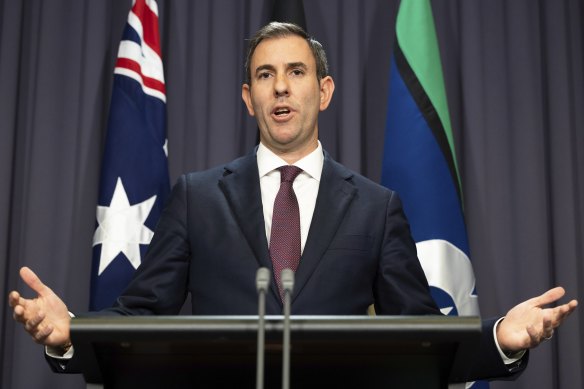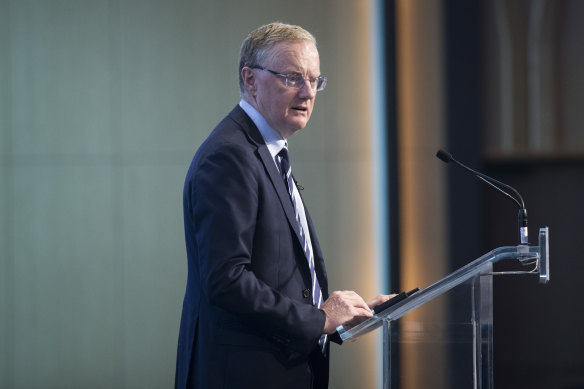By Shane Wright
The Reserve Bank faces reform rather than revolution as part of its first independent review since the early 1980s despite critics calling for the inquiry to shake up the institution’s approach to monetary policy and the way it is run.
Treasurer Jim Chalmers on Wednesday revealed the terms of reference into the bank, saying he wanted to build confidence in the RBA, which has come under fire for keeping interest rates too high before the COVID pandemic and now pushing them up too quickly in the face of surging inflation.

Treasurer Jim Chalmers says he expects reform, not revolution, of the Reserve Bank.Credit: Alex Ellinghausen
But in a sign Chalmers is prepared for changes to the bank’s executive after the review, including the position of governor Philip Lowe, the treasurer extended the term of board member Mark Barnaba by 12 months, allowing for the option of a major overhaul of the RBA’s leadership next year.
International monetary policy expert Carolyn Wilkins, leading Australian macroeconomist Renee Fry-McKibbin and Gordon de Brouwer, the secretary for public sector reform, will meet on Thursday to discuss their review, which is expected to report back to the treasurer by March.
The review followed a series of articles by this masthead about the RBA’s performance ahead of the COVID pandemic when wages growth hit record lows, unemployment remained above 5 per cent and the bank had failed to hit its inflation target for five years.
Under the terms of reference, the review panel will examine the RBA’s objectives as set out in the original 1959 act that commits the bank to full employment, stability of the currency and “the economic prosperity and welfare of the people of Australia”.
The review will also look at the bank’s inflation targeting framework, which was put in place in the early 1990s. This requires the RBA to hold inflation between 2 and 3 per cent over the economic cycle.
Chalmers said the aim of the review, which officially started on Wednesday, was to build confidence in one of the country’s most important economic institutions.
“This is not about revolutionising monetary policy in Australia. It’s about reviewing it and then refining it and reforming it,” he said.
“I don’t want it to be an exercise in pot shots or second-guessing. I don’t want it to be exclusively focused on a backward-looking, blame-shifting exercise. I want it to genuinely be about how do we have the world’s best central bank into the future.”
A criticism from outside the bank has been that its board structure, unlike almost every other major central bank, is drawn from the general community and more than half of its nine members are non-monetary policy experts.
The five-year term of Barnaba, appointed by then-treasurer Scott Morrison, is due to end on August 30, but has been extended by 12 months.
The term of another board member, Wendy Craik, ends on May 6 next year while Lowe’s seven-year term is due to end on September 17 next year.
Chalmers said there would be scope to make any necessary changes to the board after taking on recommendations from the review.

Reserve Bank governor Philip Lowe says the review of the institution will be akin to a health check.Credit: Bloomberg
Lowe, speaking in Melbourne, described the review as a “health check” and said he believed the RBA’s flexible inflation target was working well.
“My view is that flexible inflation targeting, while it has some limitations, is the best monetary policy set of arrangements for Australia and we’ll look at how best to implement flexible medium-term inflation target and the review will help us,” he said.
Monash University economist Zac Gross, who with Labor frontbencher Andrew Leigh released research this year showing the bank’s pre-COVID interest rate settings cost the country 270,000 jobs, said the terms of reference would enable a wide-ranging examination of the RBA.
He said while critics now were focused on the bank’s decision to lift interest rates to deal with inflation, the problems evident pre-COVID had to be part of the review.
“It’s important the review keep in mind the bank missed its target for four years ahead of COVID. It under-shot the target more than it’s over-shot it now which is really a case of bad luck,” he said.
Grattan Institute economic director Brendan Coates said the composition and structure of the board had to be a key part of the review.
“The RBA board is a global outlier in being composed mainly of business leaders who lack deep expertise in monetary policy. The case for allocating board seats to people with deeper experience in monetary economics is strong,” he said.
EY chief economist Cherelle Murphy said there would be good suggestions out of the review, but she does not expect major changes.
“Central banks are complex. There is an international network of them doing very similar things and they are not entirely independent. For example, rate changes or quantitative tightening or easing can impact the exchange rates of other countries,” she said.
“For this reason, I suspect the changes that will be suggested will be at the margin, but they will assist with governance and that’s welcome.”
Capital Economics senior economist Marcel Thieliant said the banking’s decision-making process, especially its monthly meeting schedule, may change as it could contribute to policy inertia.
He said the bank’s mandate could be broadened to take on other issues.
“The mandate could be adjusted to put more emphasis on the impact of monetary policy on house and other asset prices,” he said.
Cut through the noise of federal politics with news, views and expert analysis from Jacqueline Maley. Subscribers can sign up to our weekly Inside Politics newsletter here.